Living facility
Participants of this program mainly reside at the Hiroshima International Plaza (Higashi-Hiroshima City, Hiroshima Pref.), which has many years of experience serving as living facilities for foreign trainees. Japanese participants also stay here.While living there, participants take a Japanese language course given by the Hiroshima International Center and also take part in various events that bring them into contact with Japanese culture.
Refer to the Hiroshima International Plaza website for details about the facilities.
Link for the Hiroshima International Plaza
Hiroshima International Plaza |
Room |
Cafeteria |
 |
 |
 |
Participants Life
| Date | Activity |
|---|---|
| May 14 | |
| May 21 | |
| May 26 | |
| May 31 | |
| June 16 | |
| June 29 to 30 | |
| August 15 | |
| August 17 | |
| August 24 | |
| October 12 | |
| November 28 | |
| January 7 | |
| January 30 | |
| February 25 |
February 25, 2014 Participants left Hiroshima International Plaza
Participants said goodbye to their friends and staff of Hiroshima International Cooperation Center, who took a great care of the participants at HIP.
During their 9-month stay since May 14, 2013, they have enjoyed good health without any serious injuries and illnesses. With their kind care and support, they spent quality time attending the training.
With friends and the staff |
Leaving with a lot of happy memories |
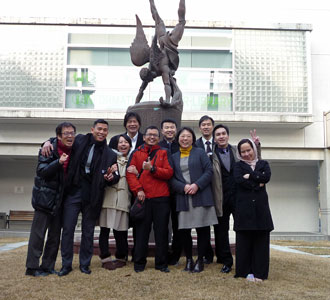 |
 |
January 30, 2014 Japanese cooking class
The Japanese class, one of the official programs for the international AJOC participants, is almost over. It is however the excitement of the class that never ends. As per request by the international participants, HIC arranged for them a cooking class where the participants had a chance on learning how to cook Japanese food. After debating among themselves during the previous class, it was then decided the types of food that they would cook which were Makizushi (rolled sushi) and Osaka style Okonomiyaki (pancake with vegetables and seafood as ingredients). 3 Sensei(instructors) were invited specially for the AJOC participants. They were Ikeda-sensei, Noda-sensei and Kouno-sensei. Thanks to Mizote-san and Ota-san for the translation, the participant could understand the instructions by the sensei.
Participants preparing Okonomiyaki |
|
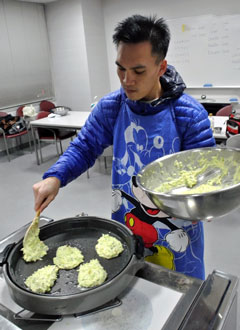 |
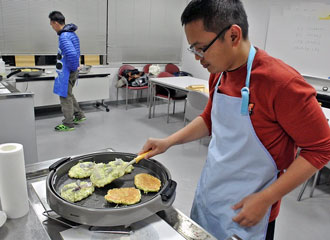 |
Participants preparing Makizushi and more |
|
 |
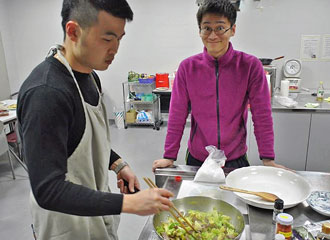 |
In the beginning, all the participants helped the sensei to prepare all the ingredients for the cooking. Driven with excitements, all the participants easily could follow the instructions given by the sensei during preparation and the cooking session. The Malaysian and the Indonesian participants looked very good in cooking Okonomiyaki while the Philippine and the Vietnamese participants looked better in making Makizushi. Apart from that, the Vietnamese participant also introduced and cooked his country food. Without knowing it, 2 hours passed so fast and it was the moment to enjoy the food that they cooked. All of them enjoyed the food very much, and then they once again asked for the ingredients and instructions on how to cook the food. So they can introduce it to their own country. At the end they thanked the sensei and the HIC staff for introducing them with very fruitful experience.
“Bon appetit” |
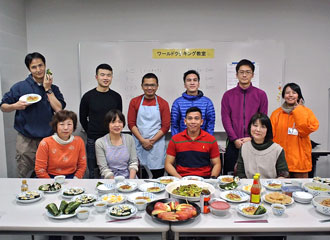 |
this one can be enlarged by clicking on this |
January 7, 2014 Calligraphy class
In the Japanese language class, today we learned about Japanese calligraphy. In Japanese, calligraphy is called Shodou (書道), or the way of writing. Harada Yusen is the name of the teacher in this class, she is a calligraphy expert. She started the class by explaining to us on the history of Japanese Kanji, which derived from Chinese character in the sixth century.
Kanji was created by using picture characters; then over time the style was developed and simplified into its current form. Kanji characters have their own typography. The three most basic styles are standard script (kaisho楷書), semi-cursive script (gyosho 行書), and cursive script (sosho草書).
Then she explained that there are over 2,000 characters in Japanese calligraphy and described some of the kanji characters’ meaning.
She also explained to us the tools used for making Japanese calligraphy. These tools are liquid ink (bokujuu墨汁), mulberry paper (washi和紙), a paper weight (bunchin文鎮) to hold the paper in place, a cloth (shitajiki下敷き) to place under the paper to prevent ink from bleeding through, and a brush (fude筆).
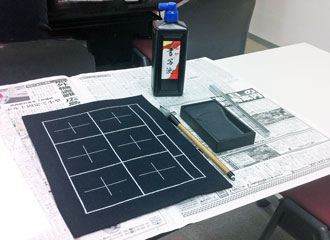 |
The tools used for writing |
She demonstrated to us how to write some kanji in calligraphy, and then let us try it by guiding us with the brush.
 |
Harada sensei guides us in writing calligraphy |
We learned from basic strokes by making such as horizontal line, vertical line, spiral and, circle, to much more difficult strokes by writing hiragana, and then kanji. We were trying to write some kanji characters on a sheet of paper, using brushes dipped in black ink. Actually Japanese characters are composed of eight basic strokes. They are the eight strokes that comprise the character for eternal, or ei (永). These eight strokes face eight different directions and are therefore known as the “eternal character eight directions," or eiji happo(永字八法).
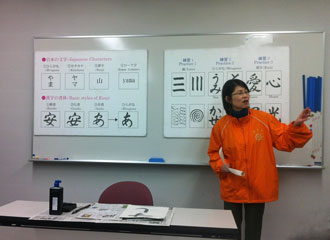 |
Step by step learning to write Japanese calligraphy |
She gave us some rules and tips while we wrote calligraphy kanji, such that when we started to write using the right hand, we should hold the edge part of the paper with the left hand so as to prevent paper from dragging. To get the correct form of calligraphy, we have to hold the brush vertically. We discovered that the standing position is the best position to write calligraphy since it could provide more balance and good view on the writing process.
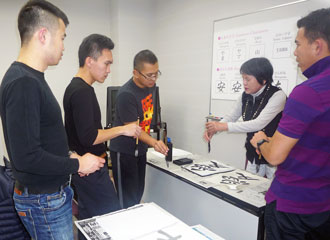 |
Harada sensei gives an example on how to hold the brush (fude) |
After hours of studying, through continuous practice to write some Japanese kanji characters, we had to choose one of our best works to be exhibited as part of the activity. We were proudly and satisfactorily happy with our works in calligraphy using kanji as we exhibited our work in the HIP lobby.
 |
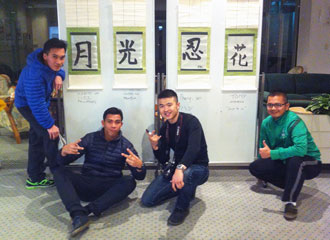 |
The proud calligraphers, their characters are ‘moon, light, calm and flower’ |
|
November 28, 2013 AJOC participants visited Kamo Senior High School
AJOC participants had a chance to take part in cultural exchanges with high school students. Although the weather was quite cold, about 3 degrees, we still felt very excited.
After 20 minutes by car coming to school, the first person whom we met in school was the English teacher. He welcomed us so much and introduced us to principal. There were many things that made us surprised at that night. The first surprise for us was the headmaster. He was not only very friendly but also very funny. Then the English teacher led us to visit some classes, which was the second surprise. We found that each class had so few students and that they did not wear uniforms. The English teacher explained to us that this was the evening class so they were more comfortable not to wear uniforms. There were some students who come from other countries, such as Vietnam and India. They were very friendly when talking with us.
Participants introducing themselves |
Participant presenting his country |
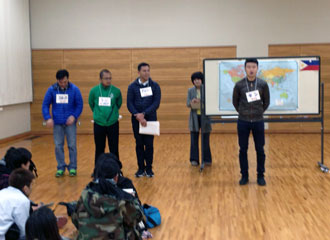 |
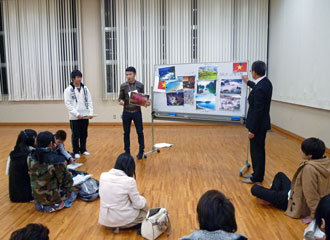 |
The meeting was held in the gym. There were about 50 students and some teachers. After being introduced in front of all the students, we introduced ourselves in Japanese. Although our Japanese were not so good, we still felt very confident because everyone there was interested in listening to us.
Next we came into four different corners of the gym, carrying documents and pictures to introduce about our countries and people in our countries. The students were also divided into four groups. They changed positions to shift among the groups, so that they could hear and understand all the countries, Indonesia, Malaysia, Philippines and Vietnam. We were very comfortable and happy during our presentation with the help of teachers and HIC staff. We could talk a lot with students. They were very friendly and lovely.
Having a good time together |
Surprised by the flowers from the students |
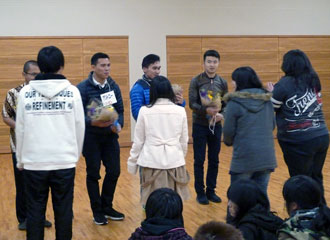 |
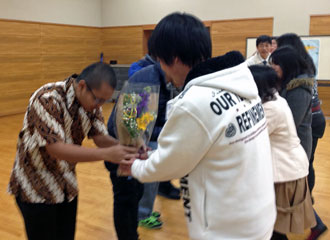 |
After more than one hour of talking, it was time to say goodbye. It was late and they had to go back home. This was the last surprise to us, the students gave us flowers. One more special thing was the gifts from the principal. That was an expensive watch for each of us.
When we came back HIP, we still felt quite happy and joked to each other that we should have cultural exchanges every week.
October 12,2013 AJOC participants joins SAKE Festival in Saijo Town
On October 12, 2013, AJOC participants had a blast to join the most awaited Saijo Sake festival in Saijo town, Higashi-Hiroshima. Sake festival in Saijo is usually held once a year at the second week of October during the start of autumn season in Japan. The unique celebration of this month is that every year for just one weekend the town of Saijo comes alive for its famous sake festival. Saijo, a well-known brewery town since around 1650, has 10 traditional breweries.
Festival weekend sees the road from the station lined with food stalls leading to Chuo park which is split into East and West. The East side has stalls, food, stages and performances with free entry. The West side of the park is where you can get to taste over 900 different types of Japan’s finest sake.
What was exciting as well for the participants was that, HIC staff and personnel made the participants join the yearly ‘Midarebayashi’ drum parade using “taiko” around the busy streets of sake festival wearing “Happi” clothes in red color along with community people and their families. If anyone wants to have a good authentic sake experience then this is the festival for someone who likes sake. There were hundreds of sakes to choose from and a great party atmosphere while beating the small paper drum.
The experience was unforgettable for the AJOC participants to have a relaxing and light moment around the place seeing everybody smiling, eating and drinking together with friends and families. Thanks to our tour guide Wada-san and HIC staff for making AJOC part of this event.
AJOC enjoying the parade festival |
Taking a break after the parade |
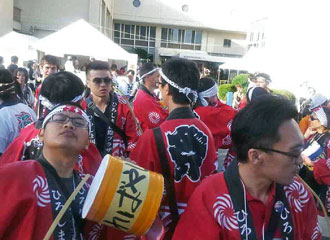 |
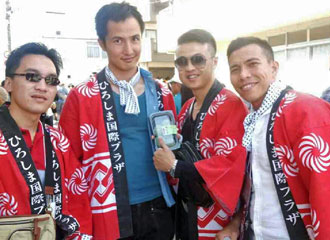 |
Tasting free Sake |
“Kaki Oishikatta” |
 |
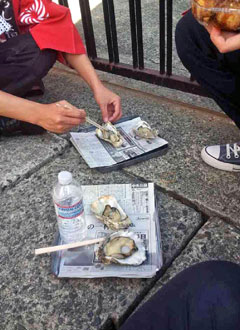 |
August 24, 2013 HIC Bus Tour
Our first experience of the bus tour set by HIC for foreign residents in Higashi-hiroshima city turned out to be a rainy day tour for us.
But before we got started with the tour, tour participants including us were directed to attend the lecture conducted by the Police department from Saijo Police station. The lecture was all about specific traffic rules and regulations including penalties for offenders. It was during this lecture that we were able to know how Japanese people strictly observed the traffic rules considering the fines/penalties that were strictly enforced to those who don’t obey road rules.
Most participants appreciated the lecture conducted by the police officer and it made us more feel secure and confident to go out anywhere in Saijo.
Briefed on traffic rules and regulations |
Mushroom farm tour |
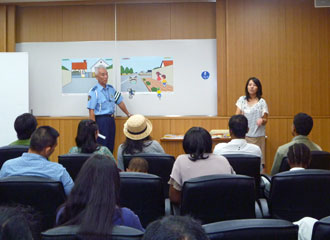 |
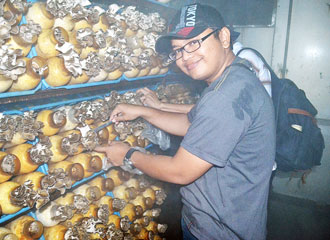 |
The first stop in this bus tour was Mushroom Farm in Kochi Town. Although the rain was continuously pouring outside, we were able to see the Mushroom making methods since it was indoor tour by the mushroom factory owner.
For us not to stay crowded inside the facilities, we were split into two (2) batches. The first batch started a tour inside the farm, and the second batch made shaved ice with mushroom powder while waiting the first batch finishing the tour.
Inside the farm, the owner explained to us from the first phase, which was the preparation phase in planting the mushroom, to the harvesting phase. The type of mushroom is known as Maitake, considered to be one of the expensive mushrooms in Japan and it is known also to be healthy for human body.
What was more exciting during this tour was that participants were able to have the chance to harvest the preserved full grown mushrooms by themselves for purposes of souvenir. So, all participants took part in picking the fresh mushrooms and brought them home as souvenir or food to taste as part of their menu.
Shaved ice making |
Tasty mushroom dish |
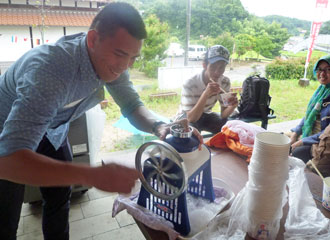 |
 |
Temporarily the weather changed to see the better view, our next trip was the sightseeing of Akitsu beach.
Because of limited time and the weather, we only enjoyed the beach scenery from inside the bus, but had no chance to go strolling in the beach sands. We observed many oyster farms along the coast line, and many small islands scattered at Seto Naikai sea.
It was such a nice view for everyone to see despite the gloomy weather at that time after we stopped over the seven eleven convenient store for some snacks and beverages.
Looking at beautiful scenery |
Old and historical town |
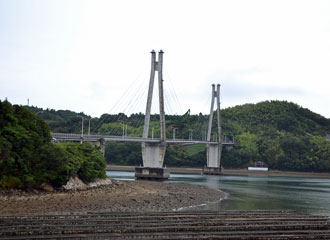 |
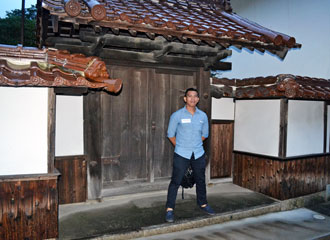 |
From the beach we went directly to Shiraichi town.
It is an old town since Edo era, the town has many old houses, a shrine, temples that still remain there from that era. Many old buildings still remain and have been preserved which aged more than 100 years’ old houses. It was fascinating how Japanese culture and tradition is still practiced until this period as reflected in the authenticity of the structures and roads that the ancestors built over the years. This is very important to preserve the Japanese culture to appreciate by future generations.
After a short tour inside Shiraichi town, we went straight directly in the town school gymnasium to watch the local Kabuki performance in Takaya-higashi elementary school.
The Kabuki story named “Shiranami Gonin Otoko.” Although we couldn’t understand the language during the performance we still enjoyed the shows by listening to the musical instruments, watching the acting performance, including the costumes and the makeups they painted in each face of characters. One of the kabuki actors came down to us and happily had the chance to have photo session with the tour participants.
A scene from Kabuki |
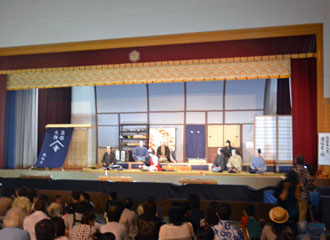 |
All in all, the simple tour ended up as a success for everybody because it was organized well despite the rainy weather and all were safely brought back in their destination as scheduled.
It was a nice and fun relaxing tour for everybody especially us AJOC participants as part of learning the Japanese culture and of course Japanese mushroom dishes.
We wish to thank the HIC staff for their effort and assistance.
August 15,2013 Katazome Dyeing
Day 8th of the summer independent study, the international AJOC participants experienced the cultural workshop called Katazome dyeing as part of Japanese language class activity at Hiroshima International Plaza. None of them had the knowledge about what it was and how to do it since it was the first time to all of them to experience such cultural workshop.
Scheduled to be held about 2 hours, the participants learned the history of the Katazome before beginning dyeing. Thanks to the help by an HIC staff, the explanation, stories and instructions by the sensei were translated. It became more exciting after they learned that all the materials were naturally made, for example, the dyeing colors came from natural rocks crushed and mixed with sake, and the decoration that needs to be colored was constructed using the steamed brown rice.
Starting to make it |
Additional instructions were given |
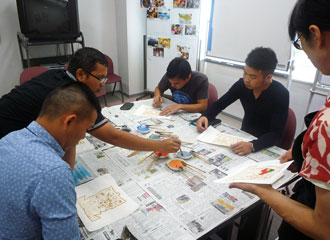 |
 |
Finished with the instructions, the sensei allowed them to begin dyeing according to their own creativities. It was surprising that all the participants have the talent of artists by themselves. The arena became silent as all of them were pleased and tried to concentrate on finishing their handwork. It seemed that they made it on their own way.
Creating their own artworks |
With their big smiles |
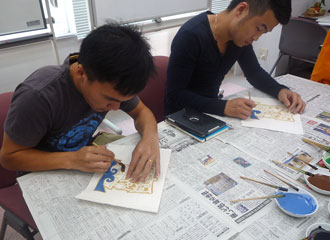 |
 |
this one can be enlarged by clicking on this |
Finished with the Katazome, the sensei introduced one more traditional dyeing skills using natural element (potato in this case) to decorate plain white banner. Here, it was more interesting since they had to craft any shapes that they like on the surface of the potato before dipping it into dye, and then trace it to the banner. It was so exciting that 2 hours seemed to be just like 20 minutes.
Using colorful and natural materials |
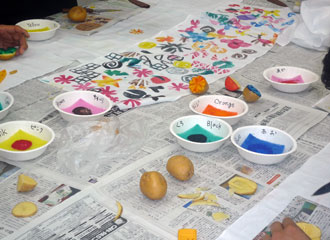 |
“We made it!” |
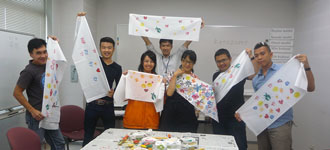 |
this one can be enlarged by clicking on this |
The participants were excited to wait for their own artworks finished as they should be dried and washed by the sensei before they can have them. They thank HIC for introducing this very exciting cultural workshop for them.
August 17,2013 Bon Odori (Dance) Festival Experience
Summer break is almost over for AJOC participants, however, one memorable happening in their stay in Japan was introduced, participating in the Bon Odori Festival.
Joined the dance practice beforehand |
Introduced themselves to the community |
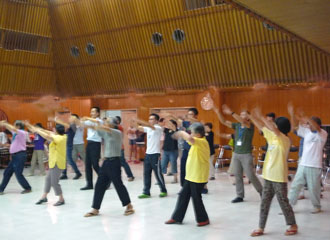 |
 |
Every 13th-to-15th day of the 7th Lunar month of the year (August), this festival is being held by the community of higashi-hiroshima particularly in Saijo near Mitate Shrine (Near Saijo Train Station). Odori means dance in Japanese. The participants enjoyed the night at the festival because they were made to dance the traditional Bon Odori in front of the community people and family. It is a group dance composed of all classes of people (old, young adults, kids including parents) with a type of Japanese music using the traditional musical instruments performing at the center stage forming a circle around the said stage.
The dance has 3 different types of moves which starts from a slow rhythm to a faster one. At first it was difficult to learn the dance but as it was repeated over and over again, we began to feel the rhythm and started enjoying the dance. It’s far different from a typical modern dance but one thing it impresses each one of us. It was because we were able to discover some of our untapped talents specifically in dancing.
Commemorative photo in yukatas |
Dancing in a circle |
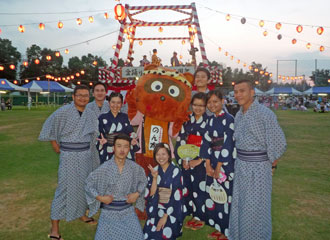 |
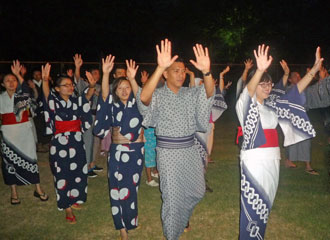 |
There were also games, and singing performance during the festival, and what really fascinating was the fireworks display which astonishes us so much because of the uniqueness of the activity how it was organized yearly.
Learning Japanese culture is very interesting for every participant, it makes us realize how important to live in a community of people, and the significance of your family. Being together in one common place creates healthy environments of people who interact and share what they have.
What a wonderful day! |
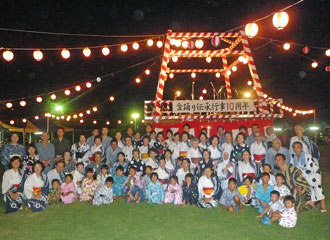 |
In line to this, the participants are looking forward for more fun and exciting Japanese culture activities.
June 29 to 30, 2013 HOMESTAY PROGRAM IN JAPAN
Finally, we have experienced living in a Japanese home for overnight on June 29 and 30 respectively. All four Asian participants from Philippines, Vietnam, Malaysia and Indonesia were feeling reluctant at first when they knew they would stay inside a typical Japanese family house near HIP. The feeling of fear and so much doubt whether they will get along well with the host family bothered their minds very much.
Well, it was actually a fun and unique experience for everyone new in Japan. Basically, as for my part I was hosted by two (2) senior couple citizens who happened to be retired teachers and who loves to drink Sake, beer and wine during their light moments at home. I was accommodated very well by my host family, and so as the others, because my host mother is a very sociable person and a very talented one. She basically likes art and music, and age is obviously not a hindrance for them to enjoy life fully as they age. She brought me to a ballroom studio where she enjoys her regular ballroom dancing practice. She demonstrated me her one talent and that made me say “wow” and I was surprised to see how she could dance so gracefully together with her sensei.
Because she likes art as well, we also went to various art galleries in Kure and Kumano. She introduced me to different authentic calligraphy artworks of the past and interpretation of some historic poems that were written on the walls. No doubt it was really fascinating to know how people in Japan love history and art in general. We also went to Kumano town next to Kurose town. It was surprising because there were not much people around inside this town. Such place was surrounded by mountains and scattered typical Japanese houses everywhere. In there we went to another art gallery called Kobo gallery. It is an art museum where artists and famous calligraphers make their own paint brushes handcrafted and very authentic. Another “wow” for me because she said this was a very rare opportunity for foreigners to visit such place. Before we left the place I bought a souvenir for my fiancee, an eyeliner brush made by hand.
Back home, they served me with nice dishes (sushi, shrimp, egg, rakkyo, tori, bamboo roots, raw sweet corn and miso soup) and lots of sake as well as canned beers. It was also my first time to use a tatami floor room for my accommodation. My host father likes to play golf and take care of his rice fields. His usual routine is to stay home and fixed everything from machines to farming. One unforgettable experience I had with him was that we went together practice golf driving lessons. It was a good thing I was able to catch up despite the big communication barriers between us. I am pretty sure he was impressed how adaptive and eager I was to learn his golf skills too.
Two days is actually not enough to know and learn their routine ways. I learned very much in my experience with them. It made me realize how life can be so simple if you wanted it to be. I believe my colleagues and I learned so much during the past two (2) days. We have established good foundation of relationship with Japanese family and learn their culture. We were to adapt to a simple and humble life and that taught us to be normal persons regardless of class, age or culture. I am thankful for all our host family and hopefully we can experience and see them again before we leave Japan next year.
Participant from Philippines |
|
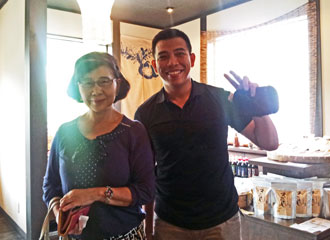 |
 |
Participant from Vietnam |
|
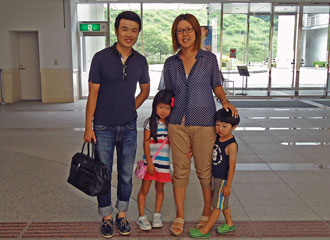 |
 |
Participant from Malaysia |
|
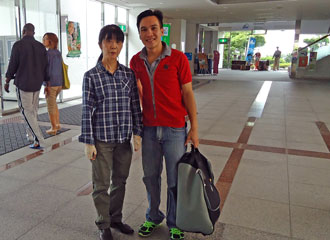 |
 |
Participant from Indonesia |
|
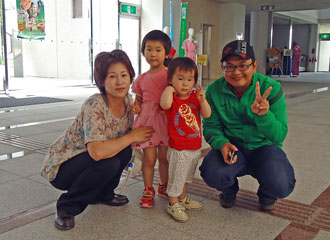 |
 |
this one can be enlarged by clicking on this |
June 16, 2013 Participants had their hair cut
After one month we arrived in Japan, we did not realize that our hair became longer, and it was time to cut our hair.
Luckily we had a barber in our group, our Vietnamese friend who has competence in cutting hair and it became his hobby. So, on the last day of the weekend, in the afternoon, there was a queue for our hair cut.
As the result, we got a new style of haircut and a new spirit to continue our study.
Open-air barbershop run by the Vietnamese participant |
 |
May 31, 2013 Japanese language night class started
The 1st Japanese class was given by Hiroshima International Center in the evening on May 31.
Participants have a 2-hour class once a week at Hiroshima International Plaza. They are learning useful phrases for their stay in Japan such as greetings and self-introduction. Practice activity outside the classroom is planned.
All the participants are interested in Japanese even before coming to Japan and they are very active in the class.
The 1st class |
Introducing himself with a smile |
 |
 |
May 26, 2013 PARTICIPANTS JOIN LOCAL ANNUAL SPORTS FESTIVAL
6 participants of the 3rd AJOC is on their third week of training and were invited to participate in the Sports Festival at Misonou Elementary School.
Group photo with other foreign participants |
Lining up together for the opening ceremony |
 |
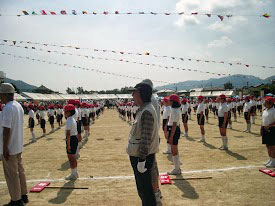 |
They have joined in different sports events with local community people including the students and parents. The opening ceremony started with a march-in displaying each National Flags of Vietnam, Philippines, Malaysia, Indonesia and Japan.
Jogging towards the first game |
Focusing not to spill the water from the scoop |
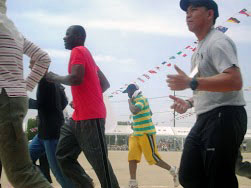 |
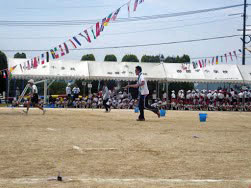 |
Each participant chose their own intended activity in the events such as ‘Let’s Eat Bread and Candy Race’, Tug-of-war, jogging water relay, throwing balls in the basket, ping-pong ball relay and lastly the exciting meter mixed relay.
Throwing balls in the basket |
Doing their best to pull the rope for the tug-of-war game |
 |
 |
The whole day was such an exhausting one but yet an unforgettable experience to the participants after having the chance to be introduced one by one in front of the audience and shared some chants with the school children. They have also made interaction with other university foreign delegates who have also joined the said activity during the day.
Rushing towards the finish line |
Foreign participants proudly displaying their flags |
 |
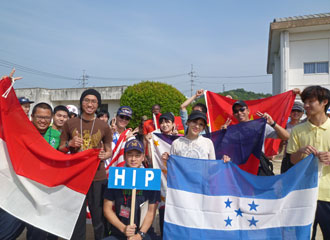 |
This photo can be enlarged by clicking on this. |
The whole day events have surely added up to the learning experience of the participants while immersing the life in Japan knowing its diverse cultures and characters. The events were something new for each country’s representatives because of the involvement of the local people interacting with foreigners. The AJOC participants can’t help but compare their country in such a unique event with their own local sports activities held every year in their own respective places.
It was also impressive how the activity was planned and conducted in a timely and organized manner by the school teachers and volunteers. Parents as well as teachers were actually joining the activities even in the run relays, bread eating and powder relay contest, not minding the heat exhaustion for which everyone felt during the day.
It was also transparent how the academe in particular has trained and molded the children in their early years of their age after series of field demonstrations and basic acrobatics that the elementary students performed in front of the crowd. The discipline was astounding. Further, the demonstrations were done accurately and gracefully in a synchronized manner together with the beat of the bass drum with individual costumes worn.
After the events, closing ceremony was then held thereafter including the Japanese flag retreat. “Banzai” as the message goes “great job to all of us” who participated in the activity. “It was such a wonderful and funny experience meeting new friends, learning new ways, and experiencing the good environment”. The participants hope to experience more of this kind of unique activities for so in the next 9 months.
May 21, 2013 Participants learned about disaster prevention in daily life
In the 1st lesson of Japanese language class, participants learned about disaster prevention in their daily life. They were briefed on what they should do in case of emergency such as earthquakes.
“What should you do?” |
Learning how to set the escape ladder |
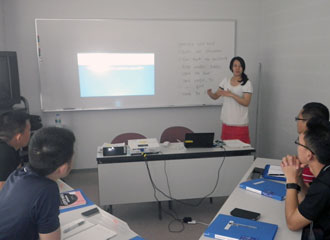 |
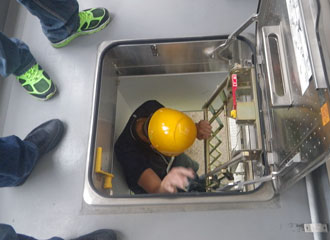 |
During the facility tour in Hiroshima International Plaza, the participants were instructed how to evacuate in case of fire.
In the fire drill, they got a helmet, shouted “fire,” and got out of the room using emergency escape ladder to the ground. They also learned and practiced how to use a fire-extinguisher.
Learning how to use the ladder |
Initial fire-fighting with nearby equipment |
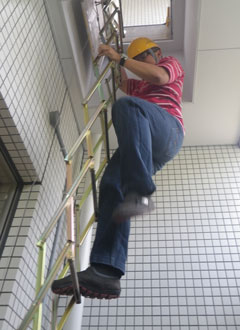 |
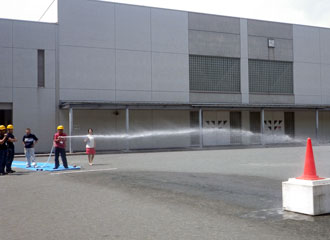 |
Finally they visited Higashi-hiroshima city fire department. They were taught how to make an emergency call and what to tell. During the observation tour they got to know how promptly the emergency service responds to a call with the advanced system. They could feel much safe and secure after the visit.
119 for fire or ambulance |
In front of the building |
 |
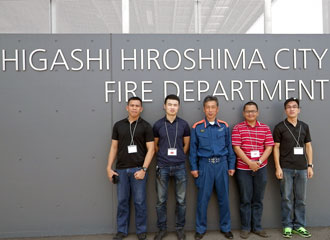 |
May 14, 2013 The life in Japan has started
Four overseas participants from Indonesia, Malaysia, the Philippines and Vietnam arrived at Hiroshima International Plaza (HIP).
After being given the brief explanation about the facility, they have started the life in Japan
arrived at HIP |
a brief explanation |
 |
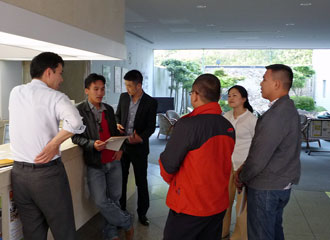 |
first dinner at HIP |
 |














